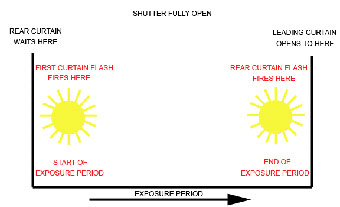 The flash synchronization strategy employed in most cameras by default is to fire the flash momentarily after the first or leading curtain of a focal-plane shutter has fully opened. Rear curtain sync flash allows the photographer to choose to fire the flash just before the rear or training curtain of a focal-plane shutter begins to close. This works well in most typical situations where the exposure period is relatively short and little subject movement is recorded.
The flash synchronization strategy employed in most cameras by default is to fire the flash momentarily after the first or leading curtain of a focal-plane shutter has fully opened. Rear curtain sync flash allows the photographer to choose to fire the flash just before the rear or training curtain of a focal-plane shutter begins to close. This works well in most typical situations where the exposure period is relatively short and little subject movement is recorded.
When slow sync flash is employed and the shutter is open for a relatively long period, subject movement may be recorded during the ambient light phase of the exposure. When photographing a moving car at night, for instance, the long ambient light exposure will record the movement of the lights throughout the duration of the exposure. If the flash is fired immediately after the shutter opens (first or leading curtain sync), the car will be illuminated and frozen at the start of the light trails which will continue after the flash is finished and throughout the ambient light exposure. The car will therefore be shown moving towards its own light trails which looks unnatural.
Second or rear curtain flash fires the flash just prior to the closure of the shutter, and hence after the light trails have been recorded during the ambient light exposure. They will therefore be seen extending behind the moving vehicle. This generally provides a more satisfactory result.
Rear curtain sync is a function offered by many SLR-type cameras, and may be switched on or off as required. It is often used in conjunction with slow sync flash but should not be confused with this technique.






